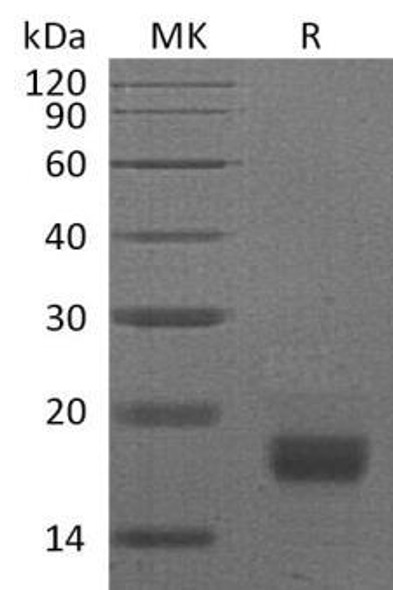Description
| Product Name: | Mouse IFNG Recombinant Protein |
| Product Code: | RPPB0401 |
| Size: | 20µg |
| Species: | Mouse |
| Target: | IFNG |
| Synonyms: | Immune Interferon, type II interferon, T cell interferon, MAF, IFNG, IFG, IFI, IFN-gamma. |
| Source: | Escherichia Coli |
| Physical Appearance: | Sterile Filtered clear solution. |
| Formulation: | IFNG protein solution (0.5mg/ml) containing 20mM Tris-HCl (pH7.5), 1mM DTT & 20% glycerol. |
| Stability: | Store at 4°C if entire vial will be used within 2-4 weeks. Store, frozen at -20°C for longer periods of time.For long term storage it is recommended to add a carrier protein (0.1% HSA or BSA).Please avoid freeze thaw cycles. |
| Purity: | Greater than 90% as determined by SDS-PAGE. |
| Amino Acid Sequence: | MGSSHHHHHH SSGLVPRGSH MGSHMHGTVI ESLESLNNYF NSSGIDVEEK SLFLDIWRNW QKDGDMKILQ SQIISFYLRL FEVLKDNQAI SNNISVIESH LITTFFSNSK AKKDAFMSIA KFEVNNPQVQ RQAFNELIRV VHQLLPESSL RKRKRSRC |
IFN-gamma produced by lymphocytes activated by specific antigens or mitogens.IFN-gamma, in addition to having antiviral activity, has important immunoregulatory functions, it is a potent activator of macrophages, and has antiproliferative effects on transformed cells and it can potentiate the antiviral and antitumor effects of the type I interferons.
Interferon-gamma Mouse Recombinant produced in E.Coli is a single, non-glycosylated polypeptide chain containing 158 amino acids (23-155a.a.) and having a molecular mass of 18.2kDa.IFNG is fused to a 25 amino acid His-tag at N-terminus & purified by proprietary chromatographic techniques.
| UniProt Protein Function: | IFNG: Produced by lymphocytes activated by specific antigens or mitogens. IFN-gamma, in addition to having antiviral activity, has important immunoregulatory functions. It is a potent activator of macrophages, it has antiproliferative effects on transformed cells and it can potentiate the antiviral and antitumor effects of the type I interferons. Homodimer. Released primarily from activated T lymphocytes. Belongs to the type II (or gamma) interferon family. |
| UniProt Protein Details: | Protein type:Membrane protein, integral; Cytokine; Secreted, signal peptide; Secreted Cellular Component: external side of plasma membrane; extracellular region; extracellular space; intracellular Molecular Function:cytokine activity; interferon-gamma receptor binding; protein binding Biological Process: adaptive immune response; antigen processing and presentation; apoptosis; CD8-positive, alpha-beta T cell differentiation during immune response; cell cycle arrest; defense response to bacterium; defense response to protozoan; defense response to virus; humoral immune response; immune response; inflammatory cell apoptosis; negative regulation of cell proliferation; negative regulation of epithelial cell differentiation; negative regulation of interleukin-17 production; negative regulation of myelination; negative regulation of smooth muscle cell proliferation; negative regulation of transcription from RNA polymerase II promoter; neutrophil apoptosis; neutrophil chemotaxis; positive regulation of autophagy; positive regulation of CD4-positive, CD25-positive, alpha-beta regulatory T cell differentiation during immune response; positive regulation of cell adhesion; positive regulation of cell proliferation; positive regulation of chemokine biosynthetic process; positive regulation of interleukin-1 beta secretion; positive regulation of interleukin-12 biosynthetic process; positive regulation of interleukin-12 production; positive regulation of interleukin-23 production; positive regulation of interleukin-6 biosynthetic process; positive regulation of isotype switching to IgG isotypes; positive regulation of killing of cells of another organism; positive regulation of membrane protein ectodomain proteolysis; positive regulation of MHC class II biosynthetic process; positive regulation of neuron differentiation; positive regulation of nitric oxide biosynthetic process; positive regulation of osteoclast differentiation; positive regulation of peptidyl-serine phosphorylation of STAT protein; positive regulation of synaptic transmission, cholinergic; positive regulation of T cell proliferation; positive regulation of transcription from RNA polymerase II promoter; positive regulation of transcription, DNA-dependent; positive regulation of tumor necrosis factor production; positive regulation of tyrosine phosphorylation of Stat1 protein; protein import into nucleus, translocation; regulation of growth; regulation of immune response; regulation of insulin secretion; regulation of the force of heart contraction; regulation of transcription, DNA-dependent; response to virus; sensory perception of mechanical stimulus; T cell receptor signaling pathway; unfolded protein response |
| NCBI Summary: | This gene encodes a soluble cytokine that is a member of the type II interferon class. The encoded protein is secreted by cells of both the innate and adaptive immune systems. The active protein is a homodimer that binds to the interferon gamma receptor which triggers a cellular response to viral and microbial infections. Mice deficient in this gene have increased susceptibility to viral, bacterial and parasitic infections and to several autoimmune diseases. [provided by RefSeq, Dec 2015] |
| UniProt Code: | P01580 |
| NCBI GenInfo Identifier: | 124480 |
| NCBI Gene ID: | 15978 |
| NCBI Accession: | P01580.1 |
| UniProt Secondary Accession: | P01580,Q542B8, |
| UniProt Related Accession: | P01580 |
| Molecular Weight: | 17,907 Da |
| NCBI Full Name: | Interferon gamma |
| NCBI Synonym Full Names: | interferon gamma |
| NCBI Official Symbol: | Ifng�� |
| NCBI Official Synonym Symbols: | Ifg; IFN-g�� |
| NCBI Protein Information: | interferon gamma |
| UniProt Protein Name: | Interferon gamma |
| Protein Family: | Interferon |
| UniProt Gene Name: | Ifng�� |
| UniProt Entry Name: | IFNG_MOUSE |










